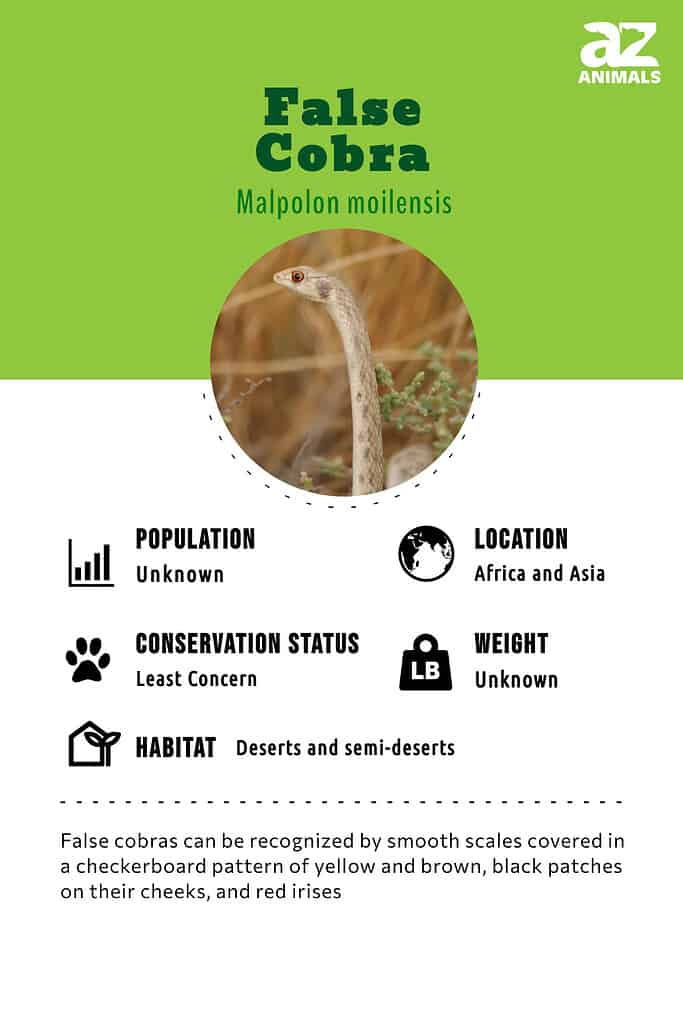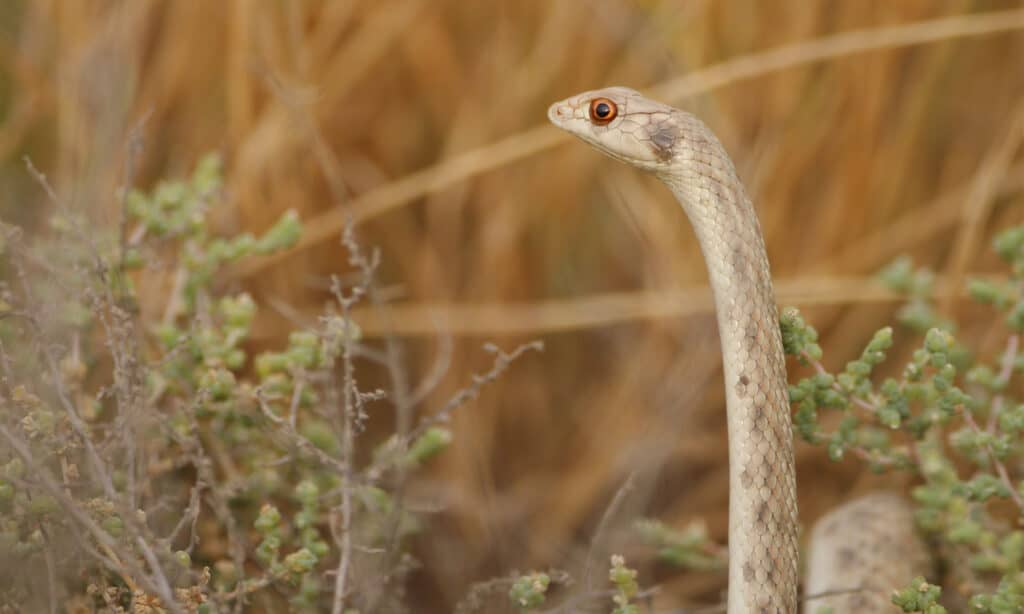False Cobra
Malpolon moilensis
When it feels threatened, it mimics a cobra in an attempt to dissuade a potential attacker.
Advertisement
False Cobra Scientific Classification
- Kingdom
- Animalia
- Phylum
- Chordata
- Class
- Reptilia
- Order
- Squamata
- Family
- Lamprophiidae
- Genus
- Malpolon
- Scientific Name
- Malpolon moilensis
Read our Complete Guide to Classification of Animals.
False Cobra Conservation Status
False Cobra Facts
- Prey
- mice, rats, and other small animals
- Fun Fact
- When it feels threatened, it mimics a cobra in an attempt to dissuade a potential attacker.
- Estimated Population Size
- The population is stable
- Most Distinctive Feature
- It mimics a cobra when it's alarmed
- Distinctive Feature
- It has an unusually long tail
- Other Name(s)
- The hooded malpolon or the Egyptian false cobra
- Gestation Period
- 60 days
- Habitat
- Deserts and semi-deserts
- Diet
- Carnivore
- Favorite Food
- Small mammals such as mice and gerbils, lizards, insects such as cockroaches and baby birds
- Common Name
- False cobra
- Number Of Species
- 1
View all of the False Cobra images!
Pretends to be a cobra
Also called the hooded malpolon or the Egyptian false cobra, this snake of the deserts and semi-deserts of the Middle East and northern Africa puts on quite a show when it’s threatened. Indeed, it has evolved to mimic the much more dangerous and much larger cobra. When it’s angry, it raises its head, flattens its neck ribs, and gives a hiss just like a cobra and hopes that’s enough to dissuade a potential attacker. Since the snake’s conservation status is least concern and its population is stable, the display is probably working for it.
Four Amazing Facts About False Cobras
- Though they’re venomous, false cobras can be kept as pets by experienced snake fanciers.
- The snake has an unusually long tail. It can be nearly 20 percent of the length of the animal.
- It’s sometimes mistaken for types of false water cobras, but they are not closely related or even members of the same genus. The hooded malpolon belongs to the Malpolon genus while other false water cobras such as the Chinese false water cobra belong to other genera.
- The false cobra is part of the diet of a moderate-sized bird called the great gray shrike, which kills it by cracking its skull with its beak and then impaling it on thorns or barbed wire.

Where To Find False Cobras
False cobras are found in the Middle East and Africa, notably in such countries as Egypt, Saudi Arabia, Jordan, Syria, Oman, Niger, Mali, Sudan, and Mauritania. They prefer habitats that are hot and dry.
Scientific Name
The false cobra’s scientific name is Malpolon moilensis. Moilensis means “from Moilah, or Al Muwaylih,” a village in Saudi Arabia. There are no subspecies.
The Different Types of False Cobra
Though M. moilensis has no subspecies, there are other snakes known as false cobras that are not related to it. The false water cobra, Hydrodynastes gigas is found in the floodplains of Brazil, Bolivia, Argentina and Paraguay. In contrast to M. moilensis, it is a semi-aquatic snake. It is also much larger in size than M. moilensis and can grow as long as 10 feet.
Pseudoxenodon snakes are also false cobras. The bamboo false cobra, Pseudoxenodon bambusicola is found in Thailand and southern Chinese forests. Like the false water cobra, it lives in habitats that contain bodies of water. Its cousin, Pseudoxenodon macrops, the Chinese false cobra is also found in China, Vietnam, Thailand and as far north as Nepal. The dull bamboo snake, Pseudoxenodon inornatus is only found in Indonesia and lives in wet mountain forest habitats and in bamboo groves.
Evolution
As members of the Malpolon genus, false cobras are also cousins of the eastern Montpellier snake and the Montpellier snake which also belong to this same small collective. Through this genus, they all form part of the Psammophiidae family which itself consists of seven other genera, or eight genera in total.
As a result, members of the Malpolon genus are also related to arrow snakes, Branch’s beaked snakes, dwarf beaked snakes, dwarf sand snakes, rufous beaked snakes, and viperine rock snakes.
Their history, like that of all snakes goes far back in time to the Cretaceous Period, about 66 -145 million years ago. However, it is during the Paleocene, between 56 – 66 million years ago that the ancestors of several modern snakes emerged.
How To Identify False Cobras: Appearance and Description
Egyptian false cobras are cylindrical snakes of medium size and are usually between 2.62 and 6.23 feet long, though they rarely grow over 5 feet. The top and sides of its body are yellow with brown spots, which creates a pleasing checkerboard pattern, and there is a black patch that covers the snake’s cheek to its jawline. Its ventral area is cream-colored, and its scales are smooth. The snake has a long head and pointed snout, and the eyes are round, large, and have red pupils.
Venom: How Dangerous Are They?

When false cobras feel threatened, they mimic a cobra as a defense.
©iStock.com/Abdelrahman M Hassanein
The venom of the false cobra is not lethal to humans, but if the snake bites and injects venom into the skin, there can be swelling, and the pain can be severe. This is one reason why taking care of this snake as a pet is probably for more experienced owners. Some of these snakes are aggressive and really don’t like to be handled while others are very docile.
Behavior and Humans
The false cobra is famous for its habit of hooding or flattening out the ribs in its neck when it feels threatened and giving a warning hiss. Unlike the false water cobra, Malpolon moilensis raises its head all the way up, which really makes it resemble a true cobra. It eats small mammals such as mice and gerbils, lizards, insects such as cockroaches, and baby birds. Pet snakes are fed pinkie mice, either alive or frozen. Though it will envenomate prey to subdue it, the snake is not above swallowing down prey while it is still conscious.
People who keep this snake as a pet need to be mindful of the time it molts or sheds its skin. The snake will stop eating during this time which happens every month or month and a half and lasts about a week. It should also not be handled while molting.
Biologists don’t know much about the reproduction of the false cobra, though they probably think it’s close to that of the false water cobra. These snakes lay two clutches of eggs a year for a total of between 14 and 24 eggs. The baby snakes hatch after about 60 days. With care, the hooded malpolon can live for as long as 20 years.
Similar Animals
View all 91 animals that start with FFalse Cobra FAQs (Frequently Asked Questions)
Is a false cobra venomous?
False cobras are venomous, but their venom is not life-threatening to humans. Still, a bite can be painful and lead to complications such as swelling.
Can you handle a false cobra?
You can handle some false cobras with care if they are docile. Other false cobras don’t like to be handled and will put its hood up, hiss and may bite if they feel threatened.
Are false cobras real cobras?
Snakes of the Malpolon, Pseudoxenodon or Hydrodynastes genera are not real cobras. Real cobras are mostly members of the Naja genus and the Elapidae family and are much larger in size than Egyptian false cobras. They can grow to 10 feet long. Interestingly, the king cobra, which is the only snake in the genus Ophiophagus is part of the Elapidae family and still considered to be a cobra. Indeed, it’s the king of the cobras! It can grow between 13 and 18 feet in length.
How big do Egyptian false cobras get?
Egyptian false cobras can grow to about 6 feet long but are usually smaller in size.
Why is it called a false cobra?
The snake is called a false cobra because it is not a member of a cobra genus but raises its head and flattens its neck and gives a warning hiss the same way a “real” cobra does. The false cobra’s venom is also not as potent as a cobra’s but can be problematic for a person who gets bitten.
Thank you for reading! Have some feedback for us? Contact the AZ Animals editorial team.
Sources
- Global Biodiversity Information Facility / Accessed May 4, 2022
- Reptile Database / Accessed May 4, 2022
- Smithsonian National Zoo / Accessed May 4, 2022
- LiveScience / Accessed May 4, 2022

















